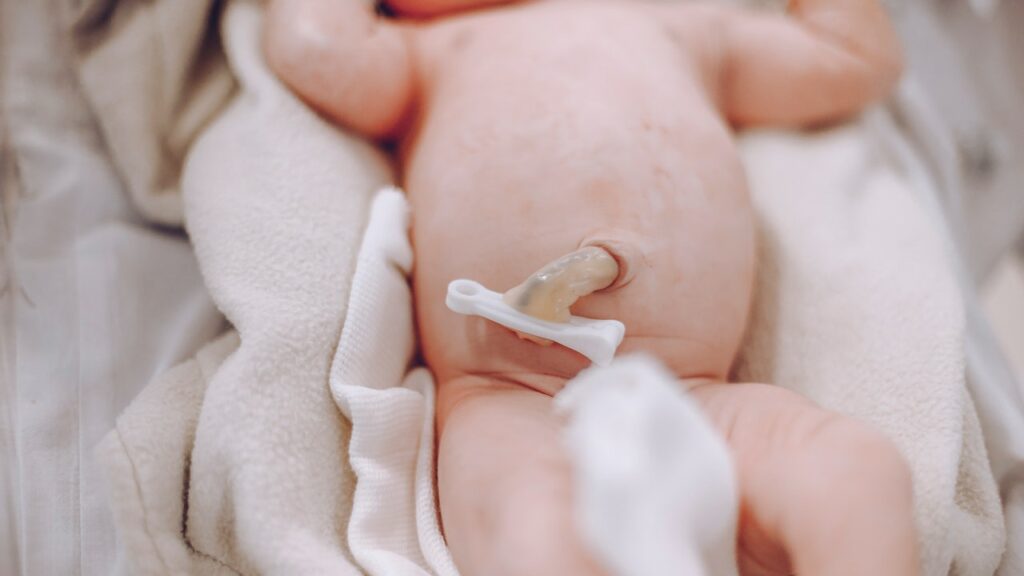It is normal practice to clamp the cord within the first 30 seconds after a full-term baby is born. Then it also became the standard procedure to delay the cord clamping with premature babies too, who need the extra blood they received from the placenta.
However, studies conducted more recently, show that both full-term and premature babies can benefit in several ways from delayed cord clamping.

What exactly is delayed cord clamping?
Delayed cord clamping, or DCC, is when an intentional decision is made to wait for a few minutes after a baby is born, before clamping and cutting the umbilical cord. Rather than clamping the cord as soon as the baby emerges, the cord is left untouched intentionally, for a certain length of time.
This time delay does vary from one birth to another, but it usually occurs within about 5 minutes after the baby is born.
Research shows that, by waiting a few minutes before clamping the cord, the baby’s blood volume can actually increase by about 33%. This extra amount of blood in the baby’s body means that there is more iron to help significantly, with developing a healthy brain.
When should delayed cord clamping not be practiced?
DCC in most cases is incredibly beneficial to babies, but there are certain times when it is not recommended, such as:
• When the mother is bleeding profusely.
• If there is a problem with the placenta, like placenta praevia, vasa praevia, placental abruption, or if the cord is bleeding and preventing the blood from reaching the baby.
• The cord might also need to be clamped soon if the baby needs help with breathing and the hospital does not have the means to do this except the mother.
However, it could be possible to delay the clamping of the cord in the time that the baby is being assessed and the breathing support begins.
What are the benefits of delayed cord clamping?
The delayed cord clamping procedure, or DCC, is practiced in most hospitals these days, with most of them clamping the cord anything from 30 seconds to 10 minutes after the baby is born. It all depends on the patient’s preferences and situation, as to how long before the cord is clamped. Provided that the baby is stable, it is very safe to wait a short while before cutting the cord.
Following are a few of the benefits of delayed cord clamping:
• Gives the blood supply a boost – babies cannot make blood cells efficiently, especially premature babies, so one of the main concerns with newborns, is that they develop anemia. However, if a baby is kept attached to the placenta for only one minute more after birth, more blood will flow from the placenta into the baby’s body.
This might not sound terribly impressive, but because a baby’s body is so small, that one minute more of blood flow increases the volume of blood by a huge amount.
Delayed cord clamping is beneficial to both full-term and premature babies, by contributing to an increased percentage of red blood cells (hematocrit), improved iron supply, as well as levels of hemoglobin.
• Increased oxygenation and survival rates in premature babies – the cardiovascular system of a newborn baby undergoes many changes in the first minutes of life. Their lungs expand, their blood vessels open up, and the blood starts flowing through the lungs and then back to their heart.
If the premature baby stays attached to the placenta, it helps to stabilize the baby because he/she is now receiving more oxygenated blood through the placenta in the adjustment time just after being born.
Extremely premature babies, especially those born younger than 31 weeks, benefit greatly from delayed clamping since it adds significantly to their chances of survival.

More Reasons to Consider Delayed Cord Clamping
The results of the tests conducted on delayed cord clamping so impressed the WHO, that they recommended DCC for all births. Apart from the above benefits, they found that babies benefitted in the following ways as well:
• Improved iron levels – it is vital that newborn babies have sufficient iron to help them to grow and develop quickly in the first few months of their lives. Although “breast is best”, it is not capable of providing all the iron that babies need to grow, so they have to rely on the stored iron in their little bodies to help them grow.
The extra blood that the baby gets with DCC after they are born, gives them that extra boost of iron they need. DCC is almost the same as taking an iron vitamin, and it makes sure that the baby’s body has enough stored iron to help with their fast growth and development.
This boost of iron can also provide long-term benefits. Just one example is the children of four years of age who had DCC when they were born, that had cognitive and motor scores that were much higher than children of the same age, whose cords were clamped immediately after birth.
• Increased levels of Myelin in the brain – Myelin, a white fatty substance, is found in the brain, where it coats and insulates the nerve endings, and is essential for proper brain function. Findings during those recent studies show that delayed cord clamping increases Myelin in the brain, resulting in improved brain development in babies.

With the ongoing research regarding delayed cord clamping, scientists are finding even more ways that babies benefit from this practice. For instance, several studies produce evidence that supports the belief that DCC can lower the risk of bleeding brain in extremely premature babies. Two other recent studies found that babies 4 months of age, who had DCC at birth, had improved developmental scores and neurological outcomes.
Are there any risks involved with delayed cord clamping?
With DCC the risk of the baby developing jaundice is increased slightly because there is an increase in the total amount of blood products coming from the placenta. This causes an elevation in bilirubin, which could be too much for the baby’s liver to handle.
Babies are regularly checked for jaundice after they are born, and it is easy to treat. Blood tests are normally carried out 24 hours after birth and then a few hours later again as required, to check the levels of bilirubin.
When bilirubin levels are too high, the baby is treated with “bili lights” (phototherapy), which helps to break down the bilirubin into levels that are easier to process. In certain cases, babies stay a bit longer in hospital so that jaundice can be treated.
There are no risks whatsoever for mothers, but if there are signs like excessive bleeding or placental abruption after giving birth, then the cord will be clamped quickly to fix the problem.
The health of both you and your baby are a top priority, however, and the only method of cord clamping to be used after your baby is born is the one that will be beneficial to both of you.

The Bottom Line
After undergoing numerous extensive studies for delayed cord clamping, scientists have come to the conclusion that it is a safe procedure for both you and your baby, and will, in fact, benefit your baby in the several ways mentioned above. Both ACOG and the WHO recommend delayed cord clamping for all babies.
However, since it is still a normal procedure to clamp the cord immediately after delivery, it is important that you speak to your midwife or doctor if you decide to go the DCC route.


